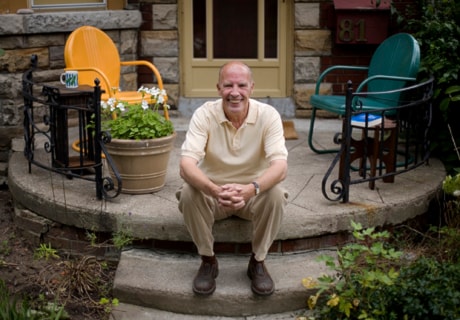MONTREAL — Patrick Conlon felt like he was in a foreign country where he didn’t know the language or the customs when he suddenly found himself watching doctors fighting to save his long-time partner from a life-threatening illness.
But Conlon decided he’d had enough of being a bystander to his partner Jim’s care when he was invited for the ambulance ride transferring Jim to another hospital, a 30-minute trip Jim wasn’t expected to survive.
“I decided I wasn’t going to be a spectator anymore,” Conlon said in a telephone interview from his Toronto home.
“I was going to be as involved as I could in his care and learn as much as I could as fast as I could about what was going on rather than spending my time in waiting rooms like a lot of people feel they’re forced to do.”
Conlon, a journalist and author who indeed became an active participant in Jim’s eventually successful treatment, has used the experience to help people who might find themselves in the same situation he did.
His book, The Essential Hospital Handbook: How to Be an Effective Partner in a Loved One’s Care, is a straightforward approach to handling a health-care crisis, a time when many people’s common sense battles fears for their loved one’s life.
The book offers a comprehensive look at emergency rooms, surgery, recovery and the hospice as it takes readers on a tour of the hospital.
Such things as living wills, drugs, hospital equipment and even slang are examined to give a well-rounded picture of what people might encounter.
While directed at caregivers and families, the book is just as helpful for patients.
Conlon acknowledges the information he’s chronicled never occurred to him before Jim got sick.
“Most of us don’t want to believe that bad things like this are going to happen and so we lead our lives always thinking it happens to other people,” he said, adding many people likely think they’re equipped after watching such TV shows as ER and House.
Conlon says involving families in patient care is common in some cultures, noting that 100 years ago, families in North America were expected to be at the patient’s bedside and collaborating with doctors and nurses.
But he added that since the end of the Second World War and the advent of wonder drugs and new technologies, some health-care professionals have focused on clinical or specific aspects of a patient’s illness rather than the whole person.
He found it ironic that while families are actively involved in a birth or in the final stages before death, “there’s a vast population in community or general hospitals between birth and death that’s being ignored.”
But Conlon insists he’s not bashing doctors and nurses and has tremendous respect for them.
And he says there is a growing acceptance in health-care circles to involving families, who can provide vital information because they know the patient intimately and do such chores as grooming, which might not be done as often because of cutbacks.
“It’s a very rewarding thing to do,” he said.
“If you can be part of the care instead of just being a spectator, it can be frankly transformative.”
He acknowledges it’s not for everyone — some people, such as mothers with young children, might not have time. Others are simply uncomfortable and prefer to defer to the experts.
But, he adds, “it’s my belief that outcomes are improved if family are present, if family are invited into the loop, if family are allowed to help. And frankly most families will respond positively.”
That’s echoed by Joan Campell of the Victorian Order of Nurses, which has been providing home care for more than 100 years in Canada.
“Family members are a link in the health care chain,” said Campbell, who oversees the Order’s Caregiver Connect website.
“They’re really the backbone of home health care.”
“If those folks are not involved, if they’re not participating, then chances are patient outcomes are going to be affected. The family can and does make a difference in patient care. It’s pretty important.”
Like Conlon, Campbell acknowledges people can be overwhelmed when they’re suddenly confronted with a health-care crisis.
“What we hear over and over . . . is that their No. 1 need is information,” she said from Ottawa. “The second thing they’re needing is emotional support because it can be pretty draining, taking care of family members and friends.”
Those needs led the Order to create its caregiver website, located at www.caregiver-connect.ca
“The idea is to provide family caregivers with information to provide better home care for their loved ones, to take care of themselves and to connect with other caregivers, people who might be able to share experiences and information.”
She said caregivers can do such things as keep lists of pertinent questions for health professionals, be the contact for the doctors, go to appointments with the patient and keep lists of things such as medicines being taken to keep medical professionals informed.
